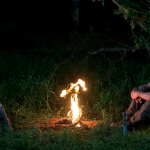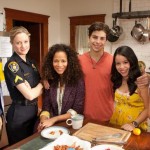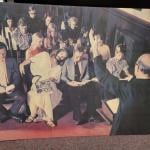Frozen River is a movie for bleak economic times that yet remains hopeful about the ability of humans to do the right thing—the right thing according to their consciences, if not exactly according to the law.
The film is set on the border between New York and Canada, and it’s clear that few economic opportunities are available in the area, either in the town proper or on the nearby Mohawk reservation. We first meet Ray Eddy (played by Melissa Leo, justly nominated for an Oscar for the role) sitting outside her trailer, smoking and crying. Her husband has just left to gamble away the money the family had been saving for a double-wide trailer.
Sounds like a sentimental set-up, doesn’t it? It’s not. One of the amazing things about this movie, especially considering that it’s a first film for writer-director Courtney Hunt, is how nimbly it avoids clichés about “trailer-park trash” or about “the deserving poor.” It’s a movie that liberals and conservatives could probably watch together happily. Ray is clearly the victim of circumstances beyond her control, but the movie also suggests that she may have made some bad financial decisions in the past. That huge, flat-screen TV in the tiny living room of her trailer, for example?
Desperate to make the payment on the new trailer to avoid losing her deposit, and unable to talk her manager into giving her more hours at her job, Ray finds herself smuggling immigrants across the border (yes, the Canadian border) along with a similarly desperate Mohawk woman named Lila. By focusing on Ray and Lila and telling us nothing of the backstories of the immigrants themselves, who are usually transferred to the trunk of Ray’s car without any personal interaction, the movie also avoids stirring up sentiment on either side about illegal immigration. This is Ray’s and Lila’s story, period. The one emotional encounter they have with an immigrant reinforces the movie’s theme of mothers’ sacrificial love for their children.
However, the aspect of the movie I most appreciated was that, while it portrays Ray’s and Lila’s self-sacrificing love for their children, it suggests that there are some limits—that it’s not okay to sacrifice other people, even out of love for your children. In other words, the film raises powerful questions about the relationship between the nuclear family and the larger community. While Frozen River suggests that concern for one’s nuclear family alone is individualistic and insular, it doesn’t exactly celebrate the tribal way of life, either: the Mohawk tribal council’s treatment of Lila is portrayed fairly negatively. The movie, instead, seems to encourage sacrificial commitment to those in similar harsh circumstances, those who may not share your blood but who do share your struggles.
While Frozen River doesn’t often explicitly deal with Christianity, the portrait of non-familial community at the end of the film is one that, to me, recalls the end of Acts 2, in which we learn that the believers “had all things in common” and shared with all, “as any had need.” Frozen River could serve as a powerful reminder to the church about how we should be living during times of hardship and plenty alike.















